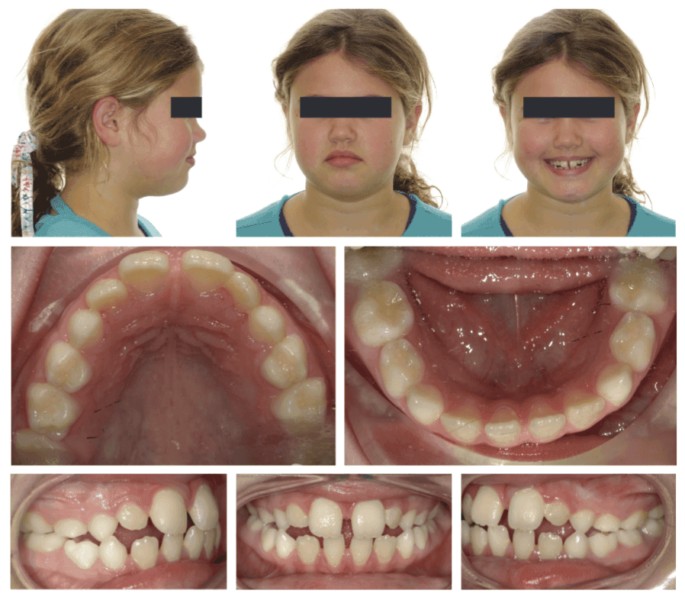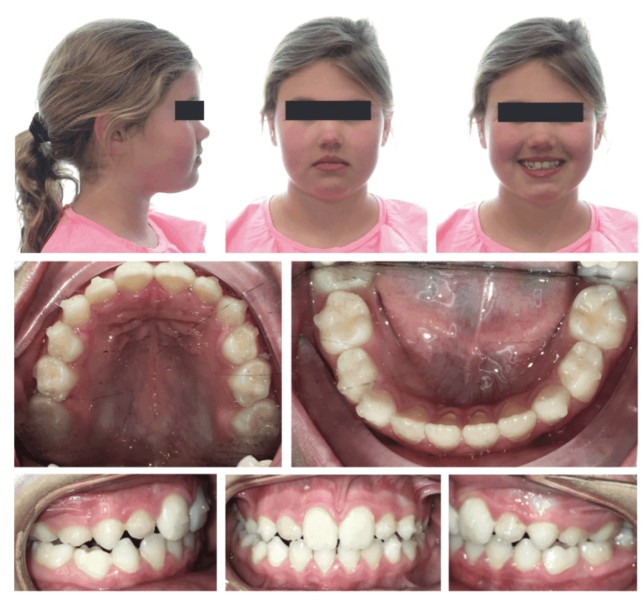CEU (Continuing Education Unit): 2 Credits
Educational aims and objectives
This clinical article aims to present a novel approach to mixed dentition treatment through a combination of technologies.
Expected outcomes
Orthodontic Practice US subscribers can answer the CE questions by taking this quiz to earn 2 hours of CE from reading this article.
Correctly answering the questions will demonstrate the reader can:
- Identify perceived benefits of screening patients for Phase I treatment beginning at 7 years old.
- Recognize some benefits of using clear aligner therapy with younger children (typically between the ages of 7 and 10).
- Recognize some reasons that younger patients would not tolerate traditional treatment as well as clear aligner therapy.
- Realize the protocol for use of the clear aligners.
- Realize the protocol for other technologies used in this type of treatment.
- Realize other necessary recommendations for patients in this category such as aligner seaters and toothpaste.
- Identify CBCT as an important part of the authors’ practice’s diagnosis and treatment planning for mixed dentition cases for the purpose of evaluating craniofacial morphology and dental development.

Drs. Jasmine Gorton and Sona Bekmezian discuss a viable treatment option for mixed dentition cases
Mixed dentition treatment can be important and effective at ensuring that patients have healthy, beautiful smiles as they grow and develop. It also lays the foundation for any ensuing orthodontic treatment experience they may have in their lifetime.
Also known as Phase I treatment or interceptive therapy, mixed dentition treatment seeks to correct focused clinical conditions while the child is still actively growing. The American Association of Orthodontists urges orthodontic screening of children at age 7. Perceived benefits of Phase 1 include1:
- Growth modification
- Prevention of dental trauma/wear
- Improved patient self-esteem and parental satisfaction
- Prevention of permanent tooth impaction
- Stability
- Less extensive subsequent treatment
The goal of this article is to present a novel approach to mixed dentition treatment through the combination of technologies usually thought to be reserved for older patients.
Protocol for mixed dentition cases
This practice was one of 54 orthodontic offices worldwide that was asked by Invisalign® (Align Technology, Inc., San Jose, California) to develop a protocol for using clear aligners for expansion in young children. Typically, patients in this category are between the ages of 7 and 10.
The traditional treatment process for these cases involves separators and metal expanders. In most situations, the patient would also receive braces on the upper and/or lower front teeth to address alignment. From sour-tasting glue, to tissue impingement, and speech and swallowing interference, these methods involve inconvenience and discomfort.2
Clear aligner therapy is hygienic, comfortable, and convenient. It is also a single simultaneous appliance, providing expansion, alignment, and upper and lower arch coordination, and thus obviating the need for fixed appliances in conjunction with expanders and/or functional appliances. As a result, in many cases, we have been able to complete Phase 1 treatments within 6 months.
In contrast to expanders and brackets, there are no dietary restrictions in clear aligner therapy and no barriers to oral hygiene. Since the aligners are removable, patients have unrestricted access to brush their teeth, floss, and receive professional prophylaxis. However, as such, clear aligners are a 100% compliance-dependent appliance.
The practice uses Invisalign® First clear aligner therapy in conjunction with the AcceleDent® Optima (OrthoAccel® Technologies, Inc., Bellaire, Texas) vibratory device. AcceleDent Optima is an FDA-cleared Class II medical device that applies precisely calibrated micropulses, which transmit through the roots of teeth to stimulate the surrounding bone and, as a result, increase cellular activity.3 Our practice has found that regular use of the AcceleDent Optima improves the predictability of mixed dentition cases, provides relief from the discomfort of tooth movement, and provides greater assurance that the aligners are tracking according to the programmed movements.
Mixed dentition patients are instructed to wear their aligners 20 to 22 hours per day, use the AcceleDent Optima for 20 minutes daily (or more, as needed for pain relief), and change aligners twice weekly (every 3 to 4 days). The practice also recommends the frequent use of Chewies™ for proper aligner seating and provides Clinpro™ 5000 (3M) sodium fluoride anti-cavity toothpaste for this age group. Our patients are able to comply with all of these instructions without the help of an adult. However, as many of our patients are unable/unwilling to brush/floss their teeth regularly following meals and snacks at school, we suggest a thorough swishing with water before replacing the aligners. Clinpro 5000 toothpaste is provided to help alleviate the risk of enamel decalcification given the likely increased plaque load. Brushing and flossing after meals and snacks is encouraged prior to aligner replacement at home.
Aligner delivery is scheduled 3 weeks after the initial record gathering and scanning appointment to minimize eruptive changes that could compromise aligner fit. Following delivery, monitoring appointments are scheduled at 6-week intervals.
Diagnosis and treatment planning
An important part of our practice’s diagnosis and treatment planning for mixed dentition cases is evaluating craniofacial morphology and dental development with cone beam computed tomography (CBCT).4 We also confirm that the airway morphology is within normal limits for the patient’s age.5
Patients and parents have a choice of treatment modality as long as they present with normal airway findings on the pretreatment CBCT and do not report symptoms of sleep-disordered breathing, for which fixed rapid maxillary expansion is prescribed.
During the treatment planning phase in Clincheck®, we strategically program attachments to optimize intrusion/extrusion, root control, and rotations. Our current protocol is to place attachments on all available permanent teeth (because these teeth tend to have larger bonding surfaces), and also on the lower deciduous first molars to address hyper-eruption of the lower anterior teeth.6 Attachments are placed during the initial aligner delivery appointment, but in our experience are best to avoid altogether in patients with special needs or hypersensitivity.
Since Invisalign® First does not currently offer a specialized retainer option for Phase 1 cases, the practice’s retention protocol is an upper removable Hawley. The practice does not prescribe mandibular retention for Phase 1 patients who have acceptable pretreatment alignment and arch length; however, cases with moderate pre-treatment misalignment are prescribed a bonded retainer on the lingual of the lower anterior teeth, and cases with severe pre-treatment lower crowding are prescribed a lower lingual holding arch.7
Patient example
An 8-year-old female presented with anterior crossbite of the lateral incisors and bilateral posterior crossbite (Figure 1). Other clinical findings included a central diastema, generalized lower spacing, a V-shaped maxillary arch, anterior open bite tendency, and excess proclination of the upper and lower anterior teeth; overjet and overbite were minimal. Further clinical examination revealed a developmentally delayed/congenitally missing lower left second premolar and ankylosis of the lower right first deciduous molar. Profile was flat, and an anterior tongue thrust was present. There were prominent mamelons on the upper central incisors and lower lateral incisors.
The treatment goals were correction of the anterior and posterior crossbites, space closure, and improvement in overjet and overbite.
Invisalign® First clear aligner therapy was recommended to achieve treatment goals comfortably and efficiently. For her initial set, the patient was prescribed 22 aligners for the maxillary and mandibular arches. Expansion was programmed into the upper arch to resolve the posterior crossbite, with simultaneous alignment of the anterior teeth for anterior crossbite resolution as well as space closure.


There was no interproximal reduction prescribed, and there were no auxiliaries used. Extrusion of upper central and lateral incisors was programmed with optimized extrusion attachments to improve smile arc. Attachments were placed at initial aligner delivery. The patient was instructed to wear her aligners 20 to 22 hours per day, use the AcceleDent Optima for 20 minutes daily, and change aligners twice weekly (every 3 to 4 days). She was also instructed to use Chewies™ for proper aligner seating and brush with Clinpro 5000 toothpaste. Appointment intervals were every 6 weeks.
There was a refinement phase of 20 aligners for the maxillary and mandibular arches (Figure 2). The refinement aligners were prescribed for increased lateral expansion to achieve complete resolution of the posterior crossbite, continued space closure for the upper and lower incisors, and extrusion of the upper anterior teeth for increased overbite.
The patient completed active treatment in 6 months (Figure 3). All treatment goals were achieved, including improved axial inclination of the anterior teeth and improved interincisal angle. The author was also pleased with the esthetic smile line and arch coordination.
The patient was prescribed an upper Hawley retainer (with the acrylic cut away from the posterior teeth to allow for unimpeded permanent tooth eruption) for daily nighttime wear. A fixed lingual retainer was bonded to the lower central and lateral incisors to maintain space closure.

Discussion
Phase I treatment with aligners is still relatively uncommon. This case report, as well as others that are pending publication, should provide validation that this treatment approach is not only a viable treatment modality for mixed dentition cases, but also an advantageous option.
Aligners allow orthodontists to simultaneously achieve anterior alignment, posterior expansion, and arch coordination. Aligners also provide the flexibility to regain space in the canine area if the patient has early loss of deciduous canines or a midline shift.
While the fact that these patients are constantly growing throughout treatment can present challenges, the benefit lies in their rapid biological response. Additionally, these patients tend to have a more regimented sleep routine of 10 or more hours of sleep per night.8 This longer sleep cycle allows uninterrupted aligner wear for longer stretches of time, improving total compliance. All of these factors contribute to the successful and predictable treatment of many mixed dentition patients within 6 months.
After reading about this mixed dentition treatment, check out “Early treatment of anterior open bites,” by Dr. Bradford N. Edgren.
References
- Suresh M, Ratnaditya A, Kattimani VS, Karpe S. One Phase versus Two Phase Treatment in Mixed Dentition: A Critical Review. J Int Oral Health. 2015;7(8):144–147.
- Gecgelen M, Aksoy A, Kirdemir P, et al. Evaluation of stress and pain during rapid maxillary expansion treatments. J Oral Rehabil. 2012;39(10):767-775.
- Pavlin D, Ravikumar A, Vishnu, Gakungaa PT. Cyclic loading (vibration) accelerates tooth movement in orthodontic patients: A double-blind, randomized controlled trial. Semin Orthod. 2015;21(3):187-194.
- Scarfe WC, Azevedo B, Toghyani S, Farman AG. Cone Beam Computed Tomographic imaging in orthodontics. Aust Dent J. 2017;62(suppl 1):33-50.
- Alwadei AH, Galang-Boquiren MTS, Kusnoto B, et al. Computerized measurement of the location and value of the minimum sagittal linear dimension of the upper airway on reconstructed lateral cephalograms compared with 3-dimensional values. Am J Orthod Dentofacial Orthop. 2018;154(6):780-787.
- Liu Y, Hu W. Force changes associated with different intrusion strategies for deep-bite correction by clear aligners. Angle Orthod. 2018;88(6):771-778.
- Woods MG. Mandibular arch dimensional and positional changes in late mixed-dentition Class I and II treatment. Am J Orthod Dentofacial Orthop. 2002;122(2):180-188.
- Galland BC, Taylor BJ, Elder DE, Herbison P. Normal sleep patterns in infants and children: a systematic review of observational studies. Sleep Med Rev. 2012;16(3):213-222.
Stay Relevant With Orthodontic Practice US
Join our email list for CE courses and webinars, articles and mores


